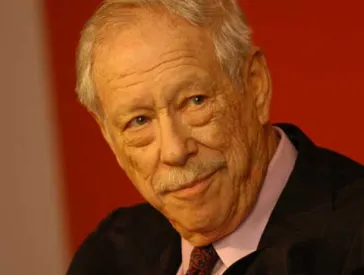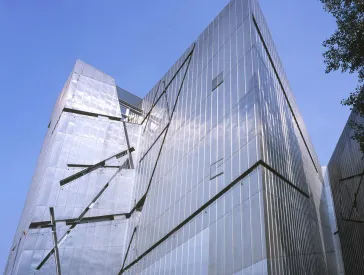
Our Museum’s History, Part Three
Political Decisions in 2001
The conflict over the Jewish Museum Berlin’s conceptual scope and financial and administrative autonomy had reached a climax with Amnon Barzel’s resignation. W. Michael Blumenthal’s appointment as Museum Director finally brought signs of resolution. Blumenthal established the museum’s independence and developed an exhibition concept with a team of experts.
Conflict Resolution
In the fall of 1997, the Berlin Senate asked the former US Treasury Secretary W. Michael Blumenthal for advice in resolving the conflict over the Jewish Museum and asked if he might take over as director. Blumenthal was born in Berlin and had been exiled with his parents to Shanghai in 1939.
Blumenthal rejected the plan to use the Libeskind building as both a Jewish museum and a city history museum. He pushed through the administrative autonomy of the Jewish Museum, which under the aegis of the Senate was initially given the status of a dependent foundation under public law on 1 January 1999. The federal government assumed control of the foundation in January 2001.
Under the leadership of Tom Freudenheim, who had been director of various Jewish institutions in the US, and Jeshajahu (Shaike) Weinberg (of blessed memory), former director of the Holocaust Memorial Museum in Washington, an exhibition on German-Jewish history was developed.
W. Michael Blumenthal, Founding Director of the Jewish Museum Berlin, 2006; Jewish Museum Berlin; photo: Sönke Tollkühn
The conflict over the Jewish Museum took place against the backdrop of political upheaval: the reunification of the two German states and the transfer of the government from Bonn to the historically contaminated terrain of the former capital of Berlin. These upheavals both intensified the conflict and led to its resolution, for the political events brought the German crimes of the Nazi era and the question of an appropriate form of remembrance onto the agenda, long postponed by the Cold War. At the same time, there was discussion about the Memorial to the Murdered Jews of Europe and the Topography of Terror. The Jewish Museum now seemed to complement these memorials.
The appointment of a commissioner for culture and media by the new German government in 1998 and the support of the first incumbent, Michael Naumann, enabled the handover of the Jewish Museum to the state in January 2001. The Jewish Museum is no longer concerned solely with the Jewish history of Berlin but with the entire history of Jews in Germany and other German-speaking territories.
Exhibition Concept and Museum Opening
After the takeover by the German government, the Jewish Museum Berlin became the sole user of the building complex in Lindenstrasse, consisting then of the baroque old building and the new building by Daniel Libeskind. The exhibition space in both buildings was to show the permanent exhibition on German-Jewish history and future temporary exhibitions.
W. Michael Blumenthal chose the anthropologist and museum manager from New Zealand, Kenneth C. Gorbey, and his partner, Nigel Cox, to design the exhibition. Both were involved in the development of the Te Papa Tongarewa national museum in Wellington, New Zealand and were now coordinating a team to open the permanent exhibition on schedule.
Ken Gorbey, Project Director of the Jewish Museum Berlin, 2000–2002; Jewish Museum Berlin; photo: Jens Ziehe
The permanent exhibition at the Jewish Museum is chronological, focusing on themes within each epoch. Featuring images, texts, artworks, everyday objects, media stations, and interactive elements, it examines Jewish culture in Germany, relations among Jews, between Jews and Christians, and between Jews and non-Jewish Germans. Beginning with Jews’ first settlements on the territory of today’s Germany during Roman times and proceeding to their first flowering in the Middle Ages, it then follows the path of emancipation in the nineteenth century to the mass emigration and the mass murder of European Jews under Nazi rule. The period after the Second World War and contemporary Jewish life in Germany conclude the exhibition.

W. Michael Blumenthal, Founding Director of the Jewish Museum Berlin, on the establishment and opening of the Jewish Museum Berlin (in German)
The exhibition concept countered the voices that had declared the Libeskind Building to be a Holocaust memorial during the debate surrounding the erection of the Memorial to the Murdered Jews of Europe. Contrary to the frequently raised demand to leave the extraordinary rooms empty, W. Michael Blumenthal and his staff saw the Jewish Museum as primarily a place for bringing Jewish history to life, not only for remembering the past.
Shabbat table and display cases in the Tradition and Change exhibition area shortly before the Jewish Museum Berlin opened; Jewish Museum Berlin; photo: Marion Roßner
On 9 September 2001, the Jewish Museum Berlin held its grand opening with a gala concert conducted by Daniel Barenboim. During the subsequent gala dinner, the then German President Johannes Rau and W. Michael Blumenthal addressed 850 prominent guests from the realms of politics, business, and culture in Germany and abroad.
The public opening, scheduled for 11 September 2001, was postponed for two days due to the terrorist attacks on the World Trade Center in New York.
Continue to the next chapter of the museum’s history, “Since the Museum Opened.”
Citation recommendation:
Jewish Museum Berlin (2020), Our Museum’s History, Part Three . Political Decisions in 2001.
URL: www.jmberlin.de/en/node/2012
History of the Museum: Ideas, Debates, Decisions, Inauguration (4)






